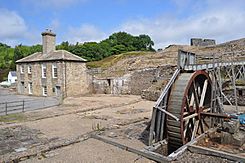London Lead Company facts for kids
The London Lead Company was a British company that mined and processed lead during the 1700s and 1800s. It was officially started by a special permission from the King or Queen, called a royal charter. Its full name was actually The Company for Smelting Down Lead with Pitcoal. This means they used coal to melt lead ore.
How the Company Started
The London Lead Company officially began in 1692. A group of investors wanted to buy lead-melting factories near Bristol from a man named Talbot Clerke. These factories used special ovens called reverberatory furnaces to melt the lead. However, this first attempt didn't work out well, and the company gave the factories back to Talbot Clerke in 1695.
Around the same time, in 1693, another group of business people, including Dr. Edward Wright, started mining for lead in Cumberland. Many of these people were Quakers, a religious group known for their strong beliefs. This group bought more lead mines in Flintshire in 1695, and this part of their business was much more successful.
In 1704, this successful group bought the royal charter from the first company, which had stopped operating. They then moved all their mining business under this old charter. The next year, they also took over another company called the Ryton Company. This company had lead-melting furnaces at Ryton on Tyne and mines in Alston Moor. This helped the London Lead Company grow even bigger.
Working in Teesdale
The London Lead Company began working in the Teesdale area in 1753. They started by leasing a mine in Newbiggin. Over time, their operations grew to cover a large area, and they built a lead-melting factory in Eggleston.
In 1815, the company moved its main office to Middleton-in-Teesdale. They built a large and impressive building called Middleton House to be their headquarters.
Because many of the company's founders were Quakers, they tried to take care of their workers. Lead mining was a very hard and dangerous job, and the conditions underground were often terrible. Working with lead ore was also very unhealthy.
In Middleton, the company built special houses for their workers. This area was called Newtown or Masterman Place. A writer from that time described it as neat and convenient cottages with gardens. The company built these houses to help their workers, as rents in Middleton were getting very high. They gave these homes to their most deserving workers. The company also encouraged its workers to practice temperance, meaning they wanted them to avoid alcohol.
The Company's End
By the late 1800s, the London Lead Company started to face problems. There was more competition from other materials, and lead was being imported from other countries. From 1895 onwards, the company slowly began to close down its mining operations. This was partly because the main leaders of the company were getting old, but mostly because the market for lead was shrinking very quickly.
The London Lead Company finally closed down in 1905. They sold their mines to another company called Vieille Montagne, which then mined for zinc in the area until the Second World War.
You can find out more about lead mining in the North East of England at the Killhope Mining Museum in Weardale.


